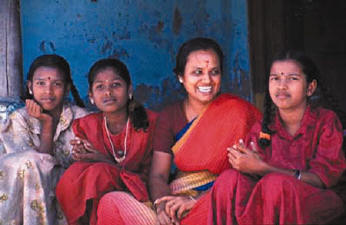|
||||||
|
THE
PEOPLE
The Balinese are small, handsome people with round, delicate features, long sweeping eyelashes, and heart-shaped lips. Their cults, customs, and worship of god and nature are animist, their music warm-blooded, their art as extravagant as their nature. Culturally, the Javanese lean more toward refinement and modesty, keeping themselves in check in life and art, while the Balinese prefer the headier, flashier sensations--laughs, terror, spicier and sweeter foods. They're more lavish and baroque in their colors and decorations; they like explosive music and fast, jerky dancing. |
|
|
Today there's still a distinction between the majapahit, descendants of 16th-century migrants of East Java's fallen Majapahit Empire, and the Bali Aga, the original inhabitants of the island who retreated into the mountains where they're found to this day, indifferent to outsiders. Among the Hinduized Balinese, the three classical Hindu castes are indicated by surnames: the Brahmans with the title Ida Bagus; the Satria with the titles Anak Agung and Cokorda; and the Vaishyas with the title Gusti. Nearly every village has a puri, the elaborate residence of a Satria, and a geria, the residence of a Brahman. The Bali Aga are Sudra, or casteless, though no Balinese is considered untouchable. Ninety percent of
Bali's population practice Bali-Hinduism. There's also a sprinkling of
Muslims in the coastal towns, Buddhists in the mountains, and Christians
everywhere. Several thousand Arabs and Indians, many hoteliers and
textile dealers, live in Denpasar. Some 25,000 Chinese live in the main
trading centers of Denpasar, Singaraja, and Amlapura, running the
majority of the small retail businesses and restaurants.
As in many Indonesian societies, menstruating women are sent out of their homes to board in a special house or compound. A Balinese man believes if menstrual blood ever touches his scalp he will be impotent for the rest of his life and follow his wife around like a dog. The birth of boy and girl twins is a calamity, an evil omen. It's thought the twins have committed incest in the womb, and rigorous purification ceremonies are required. If such twins are born in a house, the house must be destroyed; a woman who knows she's carrying twins gives birth in a hospital or outdoors to save her house. The Balinese
believe each part of the house corresponds to a part of the human
anatomy: the arms are the bedrooms and the parlor, the navel is the
courtyard, the sexual organs are the gates, the anus is the backyard
garbage pit, the legs and feet are the kitchen and granary, and the head
is the family shrine.
The banjar runs its own communal bank from which villagers may borrow to buy farm equipment, cattle, or other necessities. The banjar supports and maintains village temples, roads, and ditches; owns a gamelan; handles taxation, cockfighting, divorces, and duck herding; and helps to arrange and finance weddings, family celebrations, temple festivals, cremations, and community feasts. The banjar advises villagers on matters of religion, marriage, and morals, all regulated carefully by its elected members. Each banjar has its own meeting house where members gather in the evenings to sip tuak, talk, and gamble. The leader of the banjar is elected by its members and approved by the gods through a medium. No other political system has yet broken through the patriarchal shield of the banjar, though increasingly its cohesiveness is weakened by consumerism, modern lifestyles, and the travel industry. Many members now send a monetary contribution in lieu of their presence. |
|

